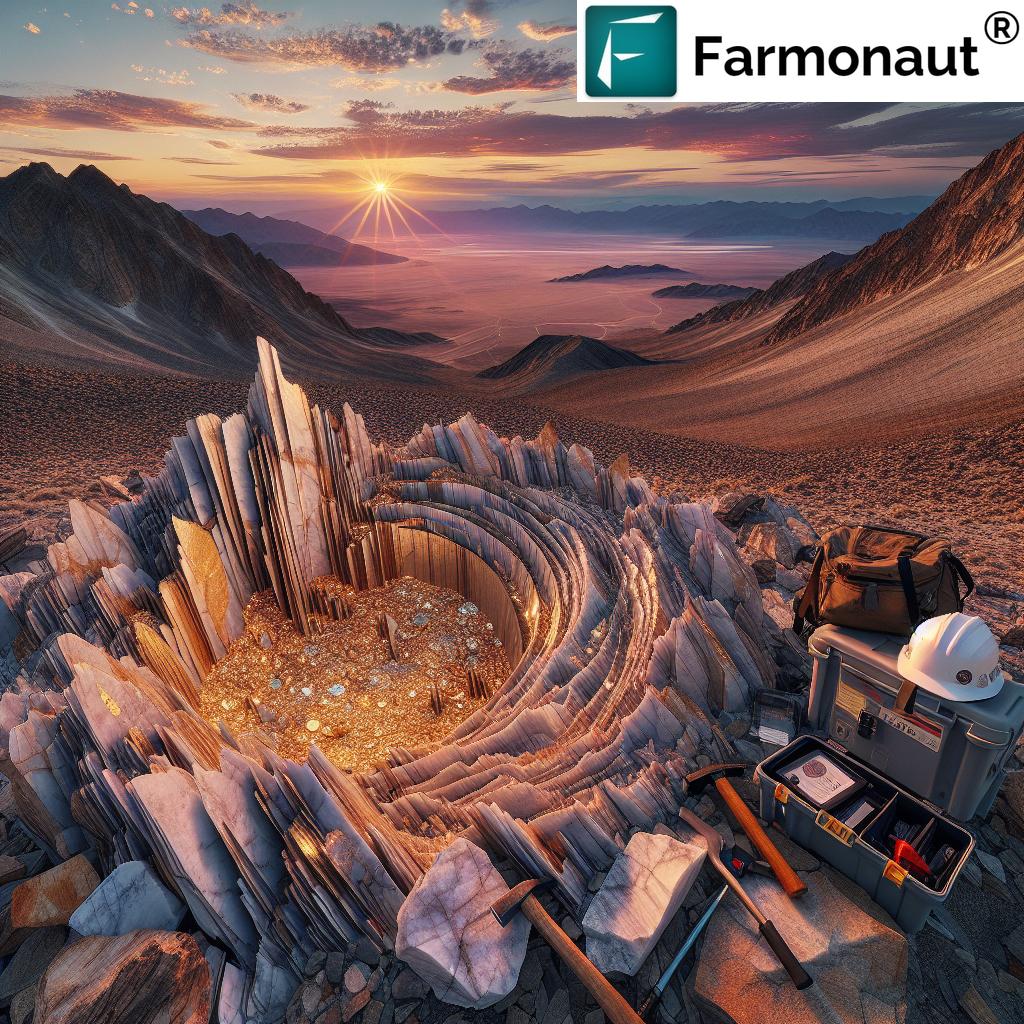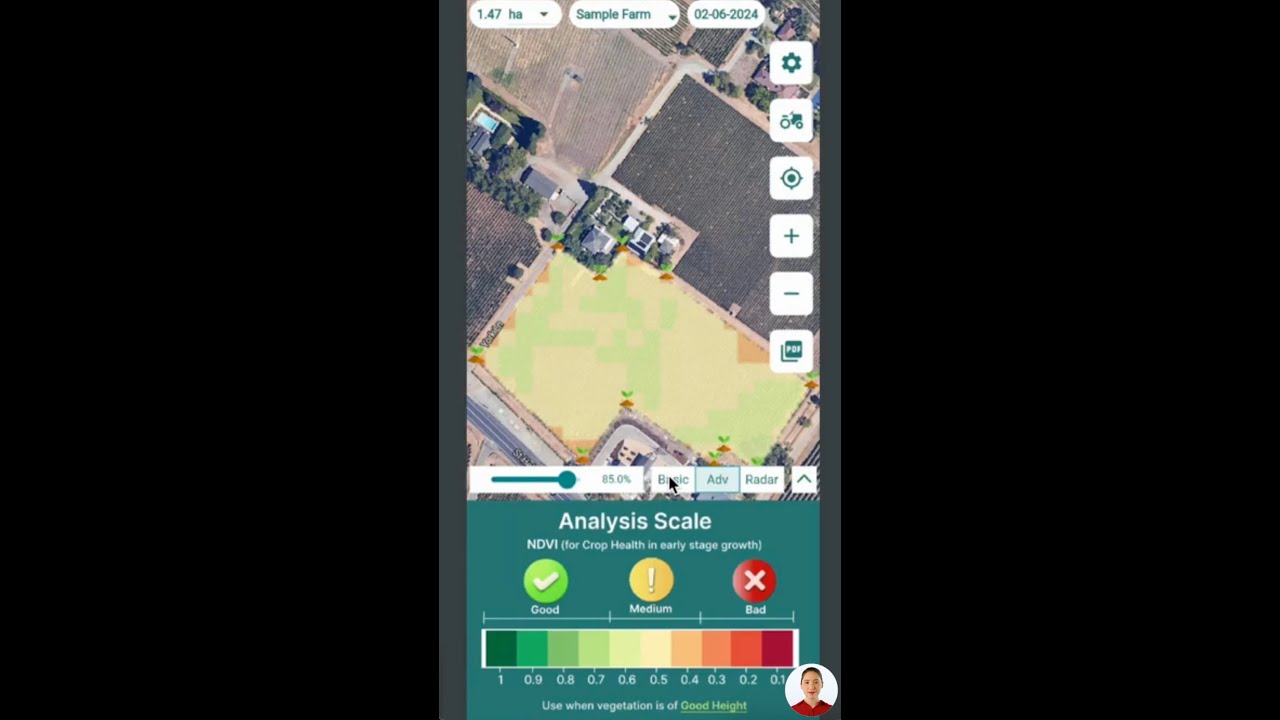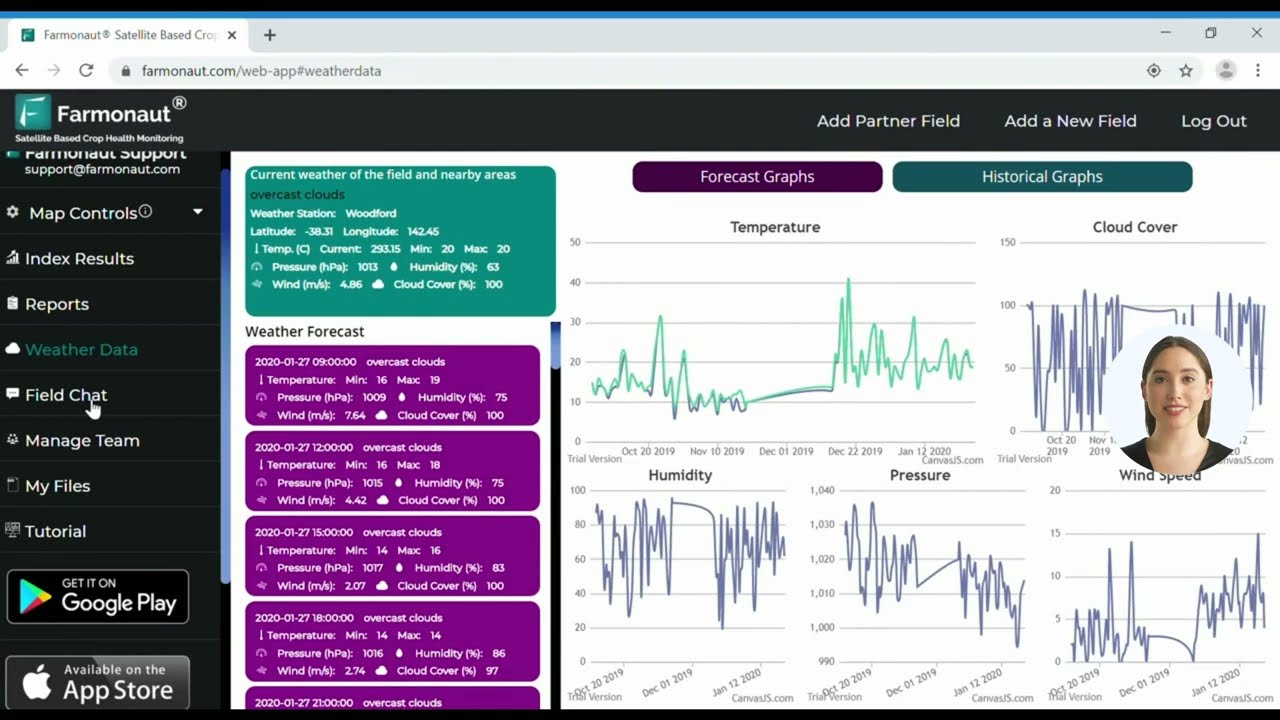Unveiling Nevada’s Golden Potential: High Sulphidation Epithermal Exploration Yields Promising Results
“Nevada exploration projects reveal alteration zones consistent with high-sulphidation lithocap environments, indicating potential for significant gold deposits.”
In the world of gold exploration, few regions capture the imagination quite like Nevada and New Mexico. These iconic landscapes, steeped in mining history, continue to yield exciting prospects for precious metal discoveries. Today, we’re thrilled to share the latest developments in high sulphidation epithermal gold exploration projects that are reshaping our understanding of these mineral-rich territories.
At Farmonaut, while our primary focus is on revolutionizing agriculture through satellite-based farm management solutions, we recognize the importance of geospatial technologies across various industries, including mineral exploration. Our expertise in satellite imagery analysis and data interpretation aligns closely with the advanced techniques being employed in modern gold exploration.
The Golden Landscape: Nevada and New Mexico’s Promising Frontiers
Nevada, often referred to as the “Silver State,” has long been synonymous with precious metal mining. However, it’s the gold potential that’s currently capturing the spotlight. Recent staking activities have led to the acquisition of three new early-stage exploration areas, each showcasing characteristics that have geologists and investors buzzing with excitement.
Similarly, New Mexico, with its diverse geological makeup, is proving to be a treasure trove for gold explorers. The state’s volcanic history and complex tectonic setting create ideal conditions for the formation of high sulphidation epithermal gold deposits.

Understanding High Sulphidation Epithermal Gold Deposits
Before delving into the specifics of the projects, it’s crucial to understand what makes high sulphidation epithermal gold deposits so intriguing to explorers:
- Formation: These deposits form near the surface, typically in volcanic environments.
- Characteristics: They’re characterized by advanced argillic alteration, often associated with large alteration zones.
- Potential: High sulphidation systems can host significant gold and silver mineralization.
- Exploration Indicators: Key indicators include quartz-alunite alteration, hydrothermal brecciation, and specific geochemical signatures.
The presence of these indicators in the newly staked areas has sparked considerable interest among geologists and investors alike.
Big Sky Project: New Mexico’s Promising Frontier
The Big Sky high sulphidation epithermal gold-silver project in western New Mexico stands out as a prime example of the potential these geological environments hold. Let’s break down the key findings:
- Location: Western New Mexico
- Geological Setting: Large area of advanced argillic alteration and silicification hosted in rhyolite volcanics
- Key Features: Zones of hydrothermal brecciation, quartz-alunite and dickite alteration
- Preliminary Results: 57 grab rock samples taken from outcrop and subcrop
- Encouraging Data: 19 samples returned over 0.1 g/t gold, with 4 exceeding 1 g/t gold (up to 3.5 g/t)
- Average Gold Content: 0.26 g/t gold across all 57 samples
These preliminary results are particularly exciting, as they suggest the presence of a potentially significant gold system. The higher-grade samples were associated with brecciated zones within parallel quartz-alunite ridges, a classic signature of high sulphidation epithermal deposits.
While Farmonaut’s primary focus is on agricultural applications, our expertise in satellite-based monitoring and data analysis can be valuable in mineral exploration contexts. For instance, our carbon footprinting solutions could be adapted to help mining companies monitor and reduce their environmental impact during exploration and extraction activities.
Nevada’s Twin Prospects: Bald Valley and White Plains
Shifting our focus to Nevada, two new projects have emerged that demonstrate the state’s enduring potential for gold discoveries:
Bald Valley Project
- Location: Eastern Nevada
- Alteration Zone: Approximately 2 km x 1 km
- Key Features: Advanced argillic alteration, silicified hematite-rich alunite ridges
- Potential: Indications of both high sulphidation epithermal and porphyry mineralization
White Plains Project
- Location: Eastern Nevada
- Alteration Zone: Similar scale to Bald Valley, roughly 2 km x 1 km
- Key Features: Advanced argillic alteration, consistent with high-sulphidation/porphyry lithocap environment
- Exploration Stage: Early, with further sampling and mapping recently completed
“Grab samples from New Mexico project returned encouraging gold values, with some exceeding 1 g/t, showcasing promising preliminary results.”
While initial sampling at these Nevada projects didn’t yield significant assays, the extensive alteration zones and geological characteristics are highly encouraging. These features suggest the potential for concealed high sulphidation epithermal and porphyry mineralization at depth.

Exploration Techniques and Future Plans
The success of these early-stage exploration projects hinges on the application of modern mineral exploration techniques. Here’s an overview of the methods being employed and planned:
- Geological Mapping: Detailed surface mapping to understand the distribution of alteration and structural controls
- Geochemical Sampling: Systematic rock and soil sampling to identify areas of anomalous gold and pathfinder elements
- Geophysical Surveys: Planned IP (Induced Polarization) surveys to map subsurface features and potential mineralization
- Drill Target Definition: Integration of all data to identify and prioritize drill targets
These exploration methods align closely with the principles of data-driven decision-making that we champion at Farmonaut. Our fleet management solutions, while designed for agricultural operations, could potentially be adapted to optimize the deployment and management of exploration equipment in remote mining areas.
Comparative Analysis of High Sulphidation Epithermal Gold Projects
| Project | Location | Alteration Zone Size | Notable Geological Features | Highest Gold Sample Value (g/t) | Exploration Stage | Planned Next Steps |
|---|---|---|---|---|---|---|
| Big Sky | Western New Mexico | Large (exact size TBD) | Advanced argillic alteration, hydrothermal brecciation | 3.5 | Early-stage | Further soil sampling, IP survey |
| Bald Valley | Eastern Nevada | ~2 km x 1 km | Advanced argillic alteration, silicified alunite ridges | TBD | Very early-stage | Additional sampling, geophysical surveys |
| White Plains | Eastern Nevada | ~2 km x 1 km | Advanced argillic alteration, lithocap environment | TBD | Very early-stage | Additional sampling, geophysical surveys |
This comparative analysis highlights the similarities and differences between the projects, showcasing the potential for significant discoveries across different geological settings in Nevada and New Mexico.
The Role of Technology in Modern Mineral Exploration
The success of these exploration projects is underpinned by the integration of cutting-edge technologies. While Farmonaut’s primary focus is on agricultural applications, many of the principles and technologies we employ have parallels in mineral exploration:
- Satellite Imagery Analysis: Just as we use multispectral satellite images for crop health monitoring, similar techniques can be applied to identify alteration zones and geological features in mineral exploration.
- AI and Machine Learning: Our Jeevn AI advisory system demonstrates the power of artificial intelligence in data interpretation. Similar AI-driven approaches are increasingly being used in mineral exploration to process vast amounts of geological and geochemical data.
- Data Integration Platforms: Farmonaut’s comprehensive farm management solutions showcase the importance of integrating multiple data sources. In mineral exploration, similar platforms are crucial for combining geological, geochemical, and geophysical data to make informed decisions.
For those interested in leveraging satellite technology for various applications, including exploration, our API offers access to powerful satellite and weather data. Developers can explore our API Developer Docs for more information on integrating these capabilities into their projects.
Environmental Considerations in Gold Exploration
As the exploration projects in Nevada and New Mexico progress, it’s crucial to consider the environmental implications of mineral exploration and potential future mining activities. Responsible exploration practices are essential to minimize the impact on local ecosystems and communities.
At Farmonaut, we understand the importance of sustainable resource management. Our carbon footprinting solutions, while primarily designed for agricultural applications, demonstrate the growing emphasis on environmental monitoring across industries. Similar principles can be applied to the mining sector to ensure exploration and extraction activities are conducted with minimal ecological impact.
The Economic Potential of High Sulphidation Epithermal Gold Deposits
The discovery and development of high sulphidation epithermal gold deposits can have significant economic implications for the regions in which they are found. These deposits often host substantial gold and silver resources, which can drive job creation, infrastructure development, and economic growth in surrounding communities.
While Farmonaut’s focus is on agricultural technology, our solutions for crop loan and insurance demonstrate the importance of financial tools in resource-based industries. Similar financial instruments and risk management strategies are crucial in the mining sector, particularly for early-stage exploration projects.
Future Outlook and Next Steps
The preliminary results from the Big Sky project in New Mexico and the promising geological features observed in the Nevada projects paint an exciting picture for the future of gold exploration in these regions. As exploration activities progress, we can expect to see:
- More detailed geophysical surveys to map subsurface structures
- Expanded geochemical sampling programs to refine target areas
- Advanced analytical techniques to better understand ore mineralogy
- Drill programs to test the most promising targets at depth
These activities will provide a clearer picture of the gold potential in these areas and could potentially lead to significant discoveries that shape the future of gold mining in Nevada and New Mexico.
Conclusion: A Golden Future for Nevada and New Mexico
The recent exploration results and ongoing projects in Nevada and New Mexico underscore the enduring potential of these regions for significant gold discoveries. The application of modern exploration techniques, combined with a deep understanding of high sulphidation epithermal systems, is opening up new frontiers in areas long known for their mineral wealth.
As these projects advance, they not only promise potential economic benefits but also drive innovation in exploration technologies and methodologies. The intersection of traditional geological knowledge with cutting-edge data analysis and remote sensing techniques is reshaping the landscape of mineral exploration.
At Farmonaut, while our primary focus remains on revolutionizing agriculture through technology, we recognize the parallels between our work and the advancements in mineral exploration. The principles of data-driven decision-making, satellite-based monitoring, and sustainable resource management are universal across resource-based industries.
As we look to the future, the golden potential of Nevada and New Mexico serves as a reminder of the opportunities that lie beneath our feet and the importance of innovative approaches in uncovering them. Whether in agriculture or mineral exploration, the key to success lies in leveraging technology, respecting the environment, and fostering sustainable practices that benefit both industry and community.
FAQ Section
- Q: What are high sulphidation epithermal gold deposits?
A: High sulphidation epithermal gold deposits are mineral deposits that form near the Earth’s surface in volcanic environments. They are characterized by advanced argillic alteration and can host significant gold and silver mineralization. - Q: Why are Nevada and New Mexico considered promising areas for gold exploration?
A: Both states have a rich history of mining and favorable geological conditions for the formation of gold deposits. Nevada, in particular, is known for its significant gold production, while New Mexico’s diverse geology creates potential for various types of mineral deposits. - Q: What are some key indicators of potential gold mineralization in these projects?
A: Key indicators include the presence of advanced argillic alteration, hydrothermal brecciation, quartz-alunite alteration, and anomalous gold values in rock and soil samples. - Q: How do modern exploration techniques differ from traditional methods?
A: Modern techniques incorporate advanced technologies such as satellite imagery analysis, AI-driven data interpretation, and sophisticated geophysical surveys. These methods allow for more precise targeting and efficient exploration compared to traditional prospecting. - Q: What are the next steps for these exploration projects?
A: Future steps include conducting detailed geophysical surveys, expanding geochemical sampling programs, and defining drill targets to test the most promising areas for gold mineralization at depth.
Earn With Farmonaut: Earn 20% recurring commission with Farmonaut’s affiliate program by sharing your promo code and helping farmers save 10%. Onboard 10 Elite farmers monthly to earn a minimum of $148,000 annually—start now and grow your income!
Learn more about our affiliate program.
Explore Farmonaut’s Agricultural Solutions
While our focus has been on mineral exploration in this article, Farmonaut’s primary mission is to revolutionize agriculture through technology. Explore our solutions:



















